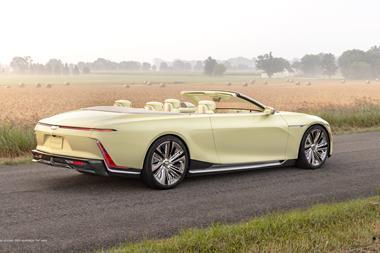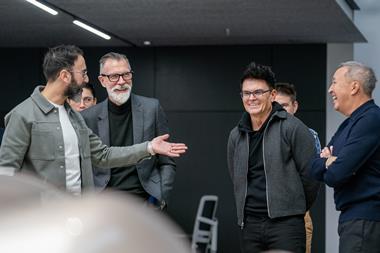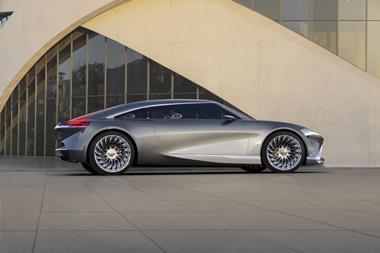Oct 17, 2000 - Could the General Motors Hummer, colossal king of SUVs, breed offspring?
Professional automotive designers, members of the media and faculty from the Center for Creative Studies - College of Art and Design (CCS) found out this afternoon, as three CCS students unveiled their concepts of Hummer progeny.
 This year’s 12th annual internship program, sponsored by American Iron and Steel Institute (AISI), required students to explore the design possibilities of an expanded Hummer range with the potential for higher manufacturing volume. The students designed with steel in mind, incorporating the latest advancements in high-strength steel, hydroforming and tailor welded blanks to reduce weight, while maintaining the visual cues that define the Hummer brand heritage.
This year’s 12th annual internship program, sponsored by American Iron and Steel Institute (AISI), required students to explore the design possibilities of an expanded Hummer range with the potential for higher manufacturing volume. The students designed with steel in mind, incorporating the latest advancements in high-strength steel, hydroforming and tailor welded blanks to reduce weight, while maintaining the visual cues that define the Hummer brand heritage.
The students, Rudolf Gonzalez, Marc Senger and David Tang, designed Hummer concepts for an expanded product range including entry-level, mid-level and luxury vehicles. The students then executed their designs in 3/10 scale clay models.
"The purchase of the Hummer brand by GM gives these students a splendid opportunity to create a high volume range comparable to the DaimlerChrysler Jeep product range, but above in market position," said Carl Olsen, Chair of Transportation Design at CCS. "This should prove to be very valuable for GM."
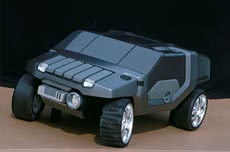 The Vigilante
The Vigilante
David Tang’s entry-level concept implies performance, functionality and industrial strength. "My concept expresses fun on the road as well as off-road activity. Though passengers sit in a low, laid back position, the vehicle retains 15 inches of ground clearance for true off-road ability," said Tang.
Interior room and spacing are unique elements of Tang’s design. "The typical owner of this vehicle is looking for sports car-like handling with roomy interior quarters," added Tang. The entry-level design offers lean mass efficiency by incorporating the latest in steel technology, such as an eye-catching roll bar made of hydroformed tubing.
 The H4-Surveyor
The H4-Surveyor
Gonzalez’s Jeep Grand Cherokee competitor boasts unique proportions, adding a more "designed" look to the originally "engineered" Hummer aesthetic. "A well-proportioned body with robust detailing is definitely the selling point of this concept," said Gonzalez.
A strong, upright A-pillar adds just enough balance to the design and opens the door for the incorporation of a more modern flare, evident in the rear window positioning. "Through the use of tailor welded blanks in the doors and roof, I’m able to lightweight the vehicle without sacrificing structural rigidity," he said. Gonzalez incorporates footsteps in the rear quarter roof surface to assist climbing atop the vehicle.
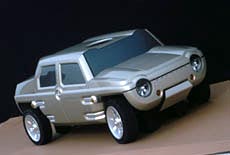 The Turbine
The Turbine
Senger’s concept stretches the limits of the imagination. From the turbine electric hybrid engine to the aircraft-inspired circular styling cues, Senger’s luxury vehicle design takes the Hummer platform to an extreme. "My concept symbolizes a move to make driving hybrid vehicles fun through function," he said.
The luxury-level Hummer utilizes hydroforming and rigid, galvanized sheet steel sections to reduce weight; exposed mechanical components for aesthetics; and unpainted components that suggest ruggedness. The luxury concept includes dimensions larger than those of the current Hummer and an additional two inches of ground clearance.
"The imagination of these students is not only promising, but also very refreshing," said Darryl Martin, senior director, Automotive Applications, AISI. "The future of automotive design looks brighter with every new project, and AISI is pleased to be a part of this on-going partnership with CCS and its transportation design program."
The Center for Creative Studies - College of Art and Design (CCS) is one of the nation’s leading arts education institutions. A private, fully accredited, four-year college, CCS offers Bachelor of Fine Arts degrees in animation and digital media, crafts, fine arts, communication design, industrial design, interior design and photography. The college also offers non-credit courses in the visual arts through its continuing and community education program. CCS is located in Detroit’s Cultural Center, where it provides a challenging learning environment in which students explore issues of art and design while preparing for careers in the professional world.
The American Iron and Steel Institute (AISI) is a non-profit association of North American companies engaged in the iron and steel industry. The Institute comprises 45 member companies, including integrated and electric furnace steelmakers, and 158 associate and affiliate members who are suppliers to or customers of the steel industry. For more news about steel and its applications, view American Iron and Steel Institute's website at http://www.steel.org.
The Automotive Applications Committee (AAC) is a subcommittee of the Market Development Committee of AISI and focuses on advancing the use of steel in the highly competitive automotive market. With offices and staff located in Detroit, cooperation between the automobile and steel industries has been significant to its success. This industry cooperation resulted in the formation of the Auto/Steel Partnership, a consortium of DaimlerChrysler, Ford and General Motors and the member companies of the AAC.
American Iron and Steel Institute/Automotive Applications Committee:
AK Steel Corporation
Bethlehem Steel Corporation
Dofasco Inc.
Ispat Inland, Inc.
LTV Steel Company
National Steel Corporation
Rouge Steel Company
Stelco Inc.
US Steel Group, a unit of USX Corporation
WCI Steel, Inc.
Weirton Steel Corporation
See also:
www.autosteel.org











